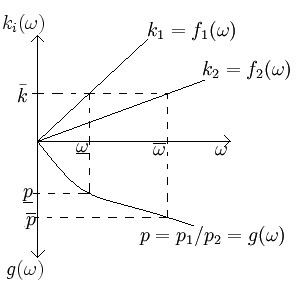 | ||
In two-sector macroeconomic models, a Harrod–Johnson diagram is a way of visualizing the relationship between the output price ratios, the input price ratios, and the endowment ratio of the two goods. Often the goods are a consumption and investment good, and this diagram shows what will happen to the price ratio if the endowment changes. The diagram juxtaposes a graph which has input price ratios as its horizontal axis, endowment ratios as its positive vertical axis, and output price ratios as its negative vertical axis. This may seem unintuitive, but doing this makes it easier to see the relationship between the output price ratios and the endowment. The diagram is named after economists Roy F. Harrod and Harry G. Johnson.
Derivation
If we let our good 1 be an investment good, governed by the equation
and good 2 be a consumption good:
On the other hand, normalizing the equation
With these three functions graphed together, we can see our relationship.
